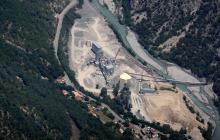While there remains low demand for aggregates in Italy, there is much needed growth in domestic construction equipment sales. Guy Woodford reports
The Italian aggregates sector has been depressed since the global economic crisis hit – with much of southern Europe, including Italy, among the worst casualties.
As the
“Many reasons stand behind this dramatic fall. The construction sector registered in the last seven years more difficulties than any other sector,” says Francesco Castagna, direttore of ANEPLA. “These are difficulties that, obviously, have had a great impact on raw material producers, such as aggregates producers.
Castagna says the first reason behind the aggregate demand slump is that the residential housing market is practically saturated, with Italy’s population stable at 60 million and 80% of them owning their flat. He notes how there are many new residential houses still unsold on the market, and the situation is mirrored in the commercial building sector. Castagna also notes that the efforts the Italian government is making to limit the national debt has also seen less investments in civil works such as roads and public buildings maintenance.
“We don’t think that in the next few years aggregates demand will grow again to its past level of demand, but we hope that we have at last reached the bottom of the crisis and the market in the future will stand more stably to a level of three tonnes/year per inhabitant, as it is the case, as far as I know, in the most of the other European countries.”
Castagna says that the impact of the huge slump in Italian aggregate demand has been particularly felt on the production side, with many small enterprise, single quarry firms producing between 200 and 400,000 tonnes/year either merging with another company, being taken over, or forced to close.
While the aggregate materials sector has made a splash in the wider business news arena with the multibillion euro merger of cement giants
As Castagna points out, the big cement players in Italy, unlike in many other European countries, represent less than 10 % of overall aggregates production.
However, Castagna is clear on what Italian Prime Minister Matteo Renzi’s government and other national and regional authorities need to do to improve demand for aggregates. “The government should consider that the construction sector is one of the main industries, if not the most important of all considering its impact on job creation, which can boost the national economy. In his policy of reduced public spending, he still has to maintain the current level of investment in infrastructures, in building and building upkeep.
“Secondly, at regional level, where responsibility for prescriptive quarrying regulations and administration lays, the current laws regarding mining and quarrying have to be updated in order to create an easier and clearer system for companies, which also reduces the charge of the so-called red tape.
| Construction equipment | Jan-Jun 2014 | Jan-Jun 2015 | % |
|---|---|---|---|
| Dozer | 15 | 7 | -53 |
| Crawler excavators | 493 | 707 | 43 |
| Wheel excavators | 35 | 60 | 71 |
| Wheel loaders | 296 | 349 | 18 |
| AWS backhoe loaders | 21 | 24 | 14 |
| Rigid backhoe loaders | 41 | 30 | -27 |
| Articulated backhoe loaders | 13 | 7 | -46 |
| Miniexcavators | 1618 | 2190 | 35 |
| Skid steer loaders | 197 | 201 | 2 |
| Compact track loaders | 112 | 123 | 10 |
| Articulated dumpers | 20 | 19 | -5 |
| Telescopic handlers | 234 | 161 | -31 |
| Tot. earthmoving machines | 3095 | 3871 | 25 |
| Compactors | 28 | 104 | 271 |
| Finishers | 11 | 55 | 400 |
| Tot. road machines | 39 | 159 | 308 |
| TOT. CONSTRUCTION EQUIPMENT |
3134 |
4030 |
29 |
“ANEPLA is pushing regional authorities to approve new quarrying laws, to lighten the charge of the red tape, encourage agreements between them, and promote a more responsible approach to the market.”
Unacea, the national association for construction equipment and attachment manufacturers, says that although the Italian construction equipment market has been affected by an 80% drop in sales from 2008 to 2013, 2014 saw highly encouraging growth of 11%.
Furthermore, the first two Unacea market surveys in 2015 show the same trend of recovery: - with a 29% rise in the first six months of the year, with 4,030 machines sold on the market (3,871 earthmoving machines and 159 road machines). However, Unacea forecasts full 2015 year growth of only 20% due to the still unstable national economy.
“In terms of production, the recovery does not show the same dynamism. In fact, the increase in 2014 has been just 1% and we forecast a +2% at the end of 2015,” says Corrado Serrentino, head of communications and public affairs at Unacea.
“With regard to foreign trade, in the first five months of 2015 Italian construction equipment exporters reported sales for €1 billion, up 6% compared to the same period of 2014. Export of tower cranes grew 26%, road machines 15%, earthmoving machines 8% and drilling equipment 4%,” Serrentino states. “Exports of crushing and screening equipment grew just 1%, while the negative trend for concrete equipment persists, with sales down 4%.”
Serrentino points out that construction equipment imports are also growing - up 31% in the first five months of 2015. “The trade balance, even if stable year-over-year, maintains a surplus of more than €750 million. In terms of destinations of the Italian equipment exported, in 2014 Asia overtook Europe (37%) as the biggest export market. However, Europe maintains a 36% share of the entire Italian construction equipment industry export market, followed by the American continent (13%), Africa (12%) and Oceania (2%).”
Leading global construction equipment OEMs such as
Like Francesco Castagna at ANEPLA, Stefano Tacchinardi, managing director of Volvo Construction Equipment Italia, Volvo CE’s Italian business, has seen the seismic impact of the global financial crisis on the national aggregates industry.
“Some companies are having to significantly reduce the number of their machines at work or even close their quarry. Nevertheless, the aggregates industry remains a very important sector in Italy and a wide number of companies are still going strong. From the middle of last year we started to see the first real signals of a recovery in demand for equipment in the quarry and aggregates segment.
In this environment, productivity and total cost of ownership are especially important to customers. Volvo CE Italia works with customers in carrying out site simulation studies and providing continuous technical support to ensure that, not only do they choose the right machine for the job, but they get the highest possible efficiency, availability, productivity, and lowest operating costs from every work shift. Volvo is a brand that customers can rely on.”
Tacchinardi says that the most popular current Volvo models for the quarry and aggregates segment in Italy are the L150H, L180H and L220H wheeled loaders, the EC220E, EC300E and EC380E excavators, and the A30G articulated hauler. “In addition to their high performance and efficiency, these machines are praised by our customers for their stable movement, comfortable operator environment and quick cycle times with excellent control,” he adds.
The Italian nation was created in the 19th century by the Risorgimento (Resurgence), a political and social movement that consolidated single states into the Italian kingdom. We await to see if the country’s aggregates and construction equipment sectors can create their own much needed and sustainable version of the nation’s stirring foundation.









